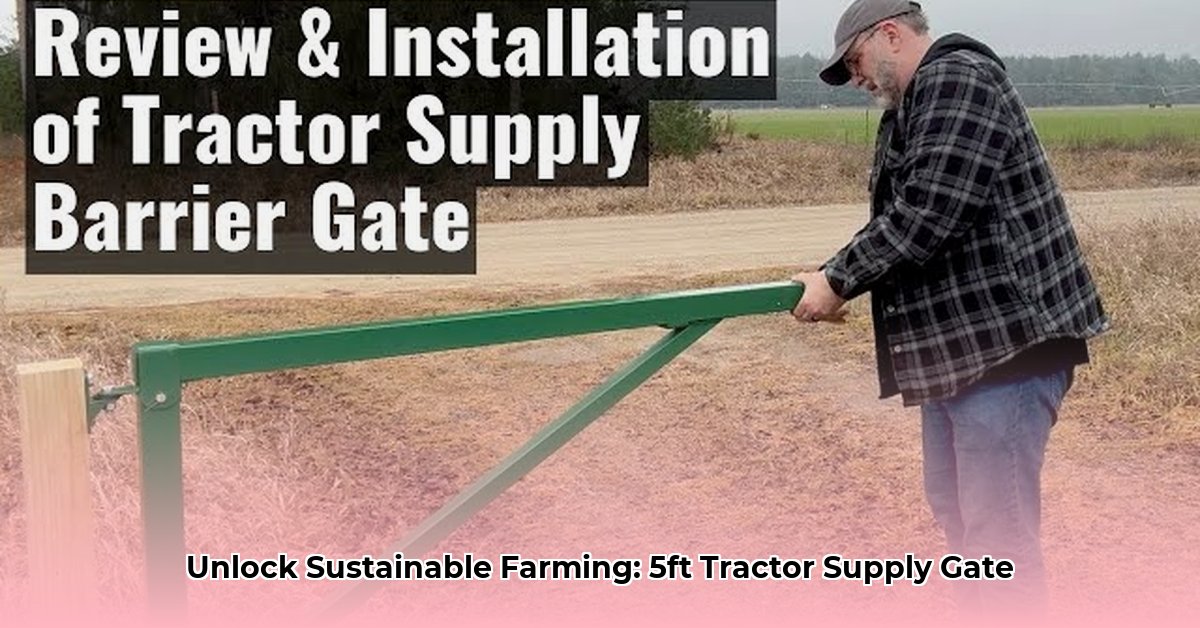
That 5-foot gate from Tractor Supply isn't just a fence; it's a cornerstone of sustainable farming practices. From efficient pasture rotation to protecting precious topsoil, a well-placed gate dramatically improves your farm's sustainability. This guide will walk you through installation, maintenance, and even creative repurposing ideas to maximize this simple but effective tool's impact. For more gate options, check out Tractor Supply gates.
Installing Your 5 ft Gate: A Step-by-Step Guide
Before you begin, gather your tools: post-hole digger, level, measuring tape, shovel, wrench (check gate instructions!), work gloves, and sturdy footwear. Safety first!
Step 1: Site Selection & Measurement: Choose a level location for your gate. Use your measuring tape to precisely mark where the gate posts will go, ensuring sufficient space for the gate to swing freely (5 feet plus extra clearance).
Step 2: Post Hole Excavation: Dig post holes to a depth that provides stability in your soil type. Aim for at least as deep as the posts are tall, or deeper if your soil is loose. Local agricultural extension services can provide soil-specific advice.
Step 3: Secure Post Placement: Carefully set posts in holes, maintaining perfect verticality using a level. Pack soil firmly around the posts. For extra stability, especially in loose soil, consider adding gravel or concrete to the base.
Step 4: Gate Installation: Follow the manufacturer's instructions for attaching hinges and the gate to the posts. Use all provided hardware and avoid over-tightening bolts.
Step 5: Functionality Check: Open and close the gate several times. Ensure smooth operation and secure latching. Make adjustments as needed.
Maintaining Your Gate for Long-Term Performance
Regular maintenance ensures years of reliable service from your gate.
Routine Cleaning: Keep the area around the gate free of mud, debris, and weeds to prevent interference with hinges and latches.
Lubrication: Periodically lubricate hinges and latches with an appropriate lubricant (e.g., silicone spray, grease) to prevent squeaking and rust, especially in humid environments.
Regular Inspections: Inspect the gate every few months for loose screws, bolts, or damaged wood. Address issues promptly to prevent escalation.
Repurposing Your Old Gate: Creative Sustainability
Don't discard an old gate! These ideas provide a sustainable repurposing path:
Raised Garden Beds: The sturdy frame can become the foundation of a raised garden bed, improving drainage and soil aeration for healthier plants.
Compost Bin: Transform the gate into a unique and aesthetically pleasing compost bin, keeping your compost secure.
A 5ft Gate: Sustainable Farming in Practice
A well-placed 5ft gate enhances many sustainable farming practices. "Efficient pasture rotation is pivotal for soil health," states Dr. Emily Carter, Agricultural Extension Specialist at State University. "Rotational grazing, facilitated by strategically positioned gates, minimizes soil compaction and promotes biodiversity." This helps prevent erosion and optimizes water management. A simple gate can make a huge difference. What are your sustainable farming goals?
Key Takeaways: Maximizing Your Gate's Impact
Improved Pasture Management: Strategic gate placement enables controlled grazing, preventing overgrazing and soil degradation.
Enhanced Soil Health: Rotational grazing, facilitated by gates, improves soil structure and nutrient cycling.
Cost-Effective Solution: The relatively low cost of a 5ft Tractor Supply gate makes it an accessible tool for improving sustainability on your farm.
This guide empowers you to harness the full potential of a simple 5ft gate, transforming your farm towards more sustainable and efficient practices. Remember, consistent maintenance and creative repurposing extend the lifespan and benefits of this invaluable tool.